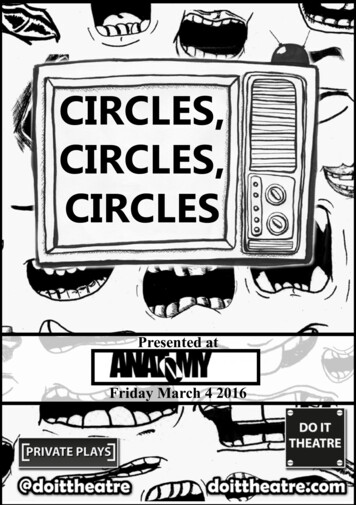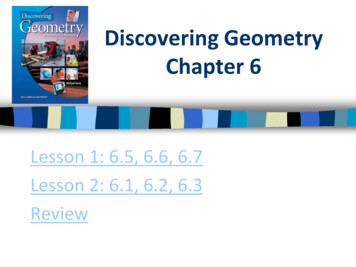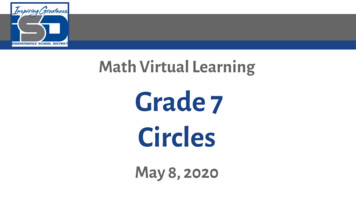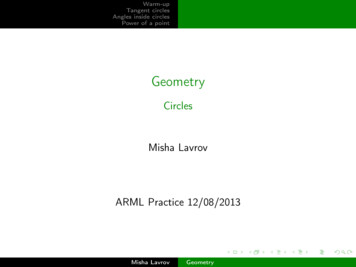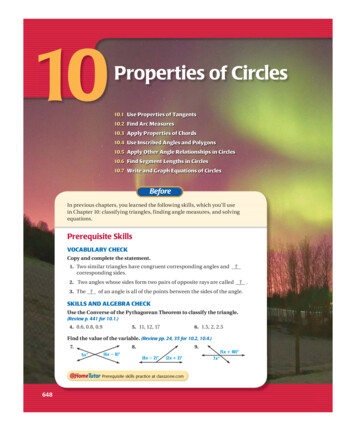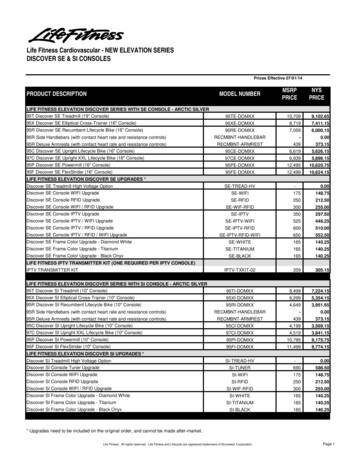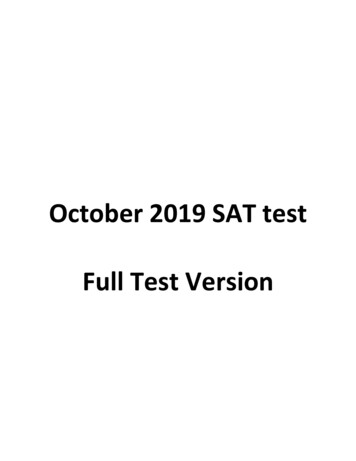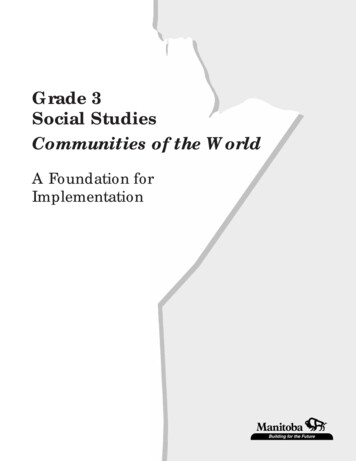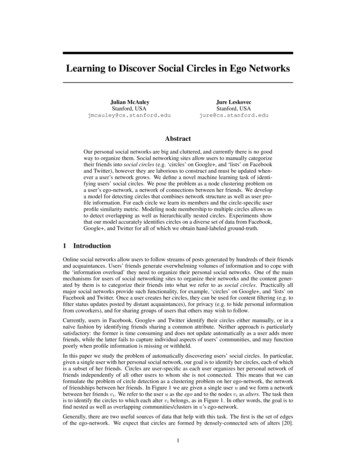
Transcription
Learning to Discover Social Circles in Ego NetworksJure LeskovecStanford, USAjure@cs.stanford.eduJulian McAuleyStanford, USAjmcauley@cs.stanford.eduAbstractOur personal social networks are big and cluttered, and currently there is no goodway to organize them. Social networking sites allow users to manually categorizetheir friends into social circles (e.g. ‘circles’ on Google , and ‘lists’ on Facebookand Twitter), however they are laborious to construct and must be updated whenever a user’s network grows. We define a novel machine learning task of identifying users’ social circles. We pose the problem as a node clustering problem ona user’s ego-network, a network of connections between her friends. We developa model for detecting circles that combines network structure as well as user profile information. For each circle we learn its members and the circle-specific userprofile similarity metric. Modeling node membership to multiple circles allows usto detect overlapping as well as hierarchically nested circles. Experiments showthat our model accurately identifies circles on a diverse set of data from Facebook,Google , and Twitter for all of which we obtain hand-labeled ground-truth.1IntroductionOnline social networks allow users to follow streams of posts generated by hundreds of their friendsand acquaintances. Users’ friends generate overwhelming volumes of information and to cope withthe ‘information overload’ they need to organize their personal social networks. One of the mainmechanisms for users of social networking sites to organize their networks and the content generated by them is to categorize their friends into what we refer to as social circles. Practically allmajor social networks provide such functionality, for example, ‘circles’ on Google , and ‘lists’ onFacebook and Twitter. Once a user creates her circles, they can be used for content filtering (e.g. tofilter status updates posted by distant acquaintances), for privacy (e.g. to hide personal informationfrom coworkers), and for sharing groups of users that others may wish to follow.Currently, users in Facebook, Google and Twitter identify their circles either manually, or in anaı̈ve fashion by identifying friends sharing a common attribute. Neither approach is particularlysatisfactory: the former is time consuming and does not update automatically as a user adds morefriends, while the latter fails to capture individual aspects of users’ communities, and may functionpoorly when profile information is missing or withheld.In this paper we study the problem of automatically discovering users’ social circles. In particular,given a single user with her personal social network, our goal is to identify her circles, each of whichis a subset of her friends. Circles are user-specific as each user organizes her personal network offriends independently of all other users to whom she is not connected. This means that we canformulate the problem of circle detection as a clustering problem on her ego-network, the networkof friendships between her friends. In Figure 1 we are given a single user u and we form a networkbetween her friends vi . We refer to the user u as the ego and to the nodes vi as alters. The task thenis to identify the circles to which each alter vi belongs, as in Figure 1. In other words, the goal is tofind nested as well as overlapping communities/clusters in u’s ego-network.Generally, there are two useful sources of data that help with this task. The first is the set of edgesof the ego-network. We expect that circles are formed by densely-connected sets of alters [20].1
Figure 1: An ego-network with labeled circles. This network shows typical behavior that we observe in our data: Approximately 25% of our ground-truth circles (from Facebook) are containedcompletely within another circle, 50% overlap with another circle, and 25% of the circles have nomembers in common with any other circle. The goal is to discover these circles given only thenetwork between the ego’s friends. We aim to discover circle memberships and to find commonproperties around which circles form.However, different circles overlap heavily, i.e., alters belong to multiple circles simultaneously [1,21, 28, 29], and many circles are hierarchically nested in larger ones (Figure 1). Thus it is importantto model an alter’s memberships to multiple circles. Secondly, we expect that each circle is not onlydensely connected but its members also share common properties or traits [18, 28]. Thus we needto explicitly model different dimensions of user profiles along which each circle emerges.We model circle affiliations as latent variables, and similarity between alters as a function of common profile information. We propose an unsupervised method to learn which dimensions of profilesimilarity lead to densely linked circles. Our model has two innovations: First, in contrast to mixedmembership models [2] we predict hard assignment of a node to multiple circles, which provescritical for good performance. Second, by proposing a parameterized definition of profile similarity, we learn the dimensions of similarity along which links emerge. This extends the notion ofhomophily [12] by allowing different circles to form along different social dimensions, an idea related to the concept of Blau spaces [16]. We achieve this by allowing each circle to have a differentdefinition of profile similarity, so that one circle might form around friends from the same school,and another around friends from the same location. We learn the model by simultaneously choosingnode circle memberships and profile similarity functions so as to best explain the observed data.We introduce a dataset of 1,143 ego-networks from Facebook, Google , and Twitter, for which weobtain hand-labeled ground-truth from 5,636 different circles.1 Experimental results show that bysimultaneously considering social network structure as well as user profile information our methodperforms significantly better than natural alternatives and the current state-of-the-art. Besides beingmore accurate our method also allows us to generate automatic explanations of why certain nodesbelong to common communities. Our method is completely unsupervised, and is able to automatically determine both the number of circles as well as the circles themselves.Further Related Work. Topic-modeling techniques have been used to uncover ‘mixedmemberships’ of nodes to multiple groups [2], and extensions allow entities to be attributed withtext information [3, 5, 11, 13, 26]. Classical algorithms tend to identify communities based on nodefeatures [9] or graph structure [1, 21], but rarely use both in concert. Our work is related to [30] inthe sense that it performs clustering on social-network data, and [23], which models membershipsto multiple communities. Finally, there are works that model network data similar to ours [6, 17],though the underlying models do not form communities. As we shall see, our problem has uniquecharacteristics that require a new model. An extended version of our article appears in [15].2A Generative Model for Friendships in Social CirclesWe desire a model of circle formation with the following properties: (1) Nodes within circles shouldhave common properties, or ‘aspects’. (2) Different circles should be formed by different aspects,e.g. one circle might be formed by family members, and another by students who attended the sameuniversity. (3) Circles should be allowed to overlap, and ‘stronger’ circles should be allowed to formwithin ‘weaker’ ones, e.g. a circle of friends from the same degree program may form within a circle1http://snap.stanford.edu/data/2
from the same university, as in Figure 1. (4) We would like to leverage both profile information andnetwork structure in order to identify the circles. Ideally we would like to be able to pinpoint whichaspects of a profile caused a circle to form, so that the model is interpretable by the user.The input to our model is an ego-network G (V, E), along with ‘profiles’ for each user v V .The ‘center’ node u of the ego-network (the ‘ego’) is not included in G, but rather G consists only ofu’s friends (the ‘alters’). We define the ego-network in this way precisely because creators of circlesdo not themselves appear in their own circles. For each ego-network, our goal is to predict a set ofcircles C {C1 . . . CK }, Ck V , and associated parameter vectors θk that encode how each circleemerged. We encode ‘user profiles’ into pairwise features φ(x, y) that in some way capture whatproperties the users x and y have in common. We first describe our model, which can be appliedusing arbitrary feature vectors φ(x, y), and in Section 5 we describe several ways to construct featurevectors φ(x, y) that are suited to our particular application.We describe a model of social circles that treats circle memberships as latent variables. Nodes withina common circle are given an opportunity to form an edge, which naturally leads to hierarchical andoverlapping circles. We will then devise an unsupervised algorithm to jointly optimize the latentvariables and the profile similarity parameters so as to best explain the observed network data.Our model of social circles is defined as follows. Given an ego-network G and a set of K circlesC {C1 . . . CK }, we model the probability that a pair of nodes (x, y) V V form an edge as()XXp((x, y) E) exphφ(x, y), θk i αk hφ(x, y), θk i .(1)Ck {x,y} Ck {x,y}{z} circles containing both nodes{zall other circles}For each circle Ck , θk is the profile similarity parameter that we will learn. The idea is thathφ(x, y), θk i is high if both nodes belong to Ck , and low if either of them do not (αk trades-offthese two effects). Since the feature vector φ(x, y) encodes the similarity between the profiles oftwo users x and y, the parameter vector θk encodes what dimensions of profile similarity caused thecircle to form, so that nodes within a circle Ck should ‘look similar’ according to θk .Considering that edges e (x, y) are generated independently, we can write the probability of G asYYPΘ (G; C) p(e E) p(e / E),(2)e6 Ee Ek 1.Kwhere Θ {(θk , αk )}is our set of model parameters. Defining the shorthand notationXdk (e) δ(e Ck ) αk δ(e / Ck ), Φ(e) dk (e) hφ(e), θk iCk Callows us to write the log-likelihood of G: XXlΘ (G; C) Φ(e) log 1 eΦ(e) .(3)e V Ve ENext, we describe how to optimize node circle memberships C as well as the parameters of the userprofile similarity functions Θ {(θk , αk )} (k 1 . . . K) given a graph G and user profiles.3Unsupervised Learning of Model ParametersTreating circles C as latent variables, we aim to find Θ̂ {θ̂, α̂} so as to maximize the regularizedlog-likelihood of (eq. 3), i.e.,Θ̂, Cˆ argmax lΘ (G; C) λΩ(θ).(4)Θ,CWe solve this problem using coordinate ascent on Θ and C [14]:Ct argmax lΘt (G; C)(5)argmax lΘ (G; C t ) λΩ(θ).(6)CΘt 1 Θ3
Noting that (eq. 3) is concave in θ, we optimize (eq. 6) through gradient ascent, where partial derivatives are given by l θk l αk X de (k)φ(e)ke V VXXeΦ(e) Ω dk (e)φ(e)k θk1 eΦ(e) e Eδ(e / Ck ) hφ(e), θk ie V VXeΦ(e) δ(e / Ck ) hφ(e), θk i .Φ(e)1 ee EFor fixed C \ Ci we note that solving argmaxCi lΘ (G; C \ Ci ) can be expressed as pseudo-booleanoptimization in a pairwise graphical model [4], i.e., it can be written asXCk argmaxE(x,y) (δ(x C), δ(y C)).(7)C(x,y) V VIn words, we want edges with high weightP(under θk ) to appear in Ck , and edges with low weight toappear outside of Ck . Defining ok (e) Ci C\Ck dk (e) hφ(e), θk i the energy Ee of (eq. 7) isEe (0, 0) Ee (0, 1) Ee (1, 0)Ee (1, 1) ok (e) αk hφ(e), θk i log(1 eok (e) αk hφ(e),θk i ), log(1 eok (e) αk hφ(e),θk i ), ok (e) hφ(e), θk i log(1 eok (e) hφ(e),θk i ), log(1 eok (e) hφ(e),θk i ), e Ee /Ee E.e /EBy expressing the problem in this form we can draw upon existing work on pseudo-boolean optimization. We use the publicly-available ‘QPBO’ software described in [22], which is able toaccurately approximate problems of the form shown in (eq. 7). We solve (eq. 7) for each Ck in arandom order.The two optimization steps of (eq. 5) and (eq. 6) are repeated until convergence, i.e., until C t 1 C t .PK P θk We regularize (eq. 4) using the 1 norm, i.e., Ω(θ) k 1 i 1 θki , which leads to sparse (andreadily interpretable) parameters. Since ego-networks are naturally relatively small, our algorithmcan readily handle problems at the scale required. In the case of Facebook, the average ego-networkhas around 190 nodes [24], while the largest network we encountered has 4,964 nodes. Note thatsince the method is unsupervised, inference is performed independently for each ego-network. Thismeans that our method could be run on the full Facebook graph (for example), as circles are independently detected for each user, and the ego-networks typically contain only hundreds of nodes.Hyperparameter estimation. To choose the optimal number of circles, we choose K so as tominimize an approximation to the Bayesian Information Criterion (BIC) [2, 8, 25],K̂ argmin BIC (K; ΘK )(8)Kwhere ΘK is the set of parameters predicted for a particular number of communities K, andBIC (K; ΘK ) ' 2lΘK (G; C) ΘK log E .(9)The regularization parameter λ {0, 1, 10, 100} was determined using leave-one-out cross validation, though in our experience did not significantly impact performance.4Dataset DescriptionOur goal is to evaluate our unsupervised method on ground-truth data. We expended significant time,effort, and resources to obtain high quality hand-labeled data.2 We were able to obtain ego-networksand ground-truth from three major social networking sites: Facebook, Google , and Twitter.From Facebook we obtained profile and network data from 10 ego-networks, consisting of 193 circles and 4,039 users. To do so we developed our own Facebook application and conducted a surveyof ten users, who were asked to manually identify all the circles to which their friends belonged. Onaverage, users identified 19 circles in their ego-networks, with an average circle size of 22 friends.Examples of such circles include students of common universities, sports teams, relatives, etc.2http://snap.stanford.edu/data/4
first nameAlanlast typefirst nameDillylast ynametypeCryptanalystGC&CSCambridgeCollege1 σx,yPrincetonGraduate SchoolCryptanalystGC&CSCryptanalystRoyal Navy01 σx,yCambridgeCollege 0 first name : Dilly 0 last name : Knox 0 first name : Alan 0 last name : Turing 1 work : position : Cryptanalyst 1 work : location : GC &CS 0 work : location : Royal Navy 1 education : name : Cambridge 1 education : type : College 0 education : name : Princeton0 education : type : Graduate School 0 first name 0 last name 1 work : position 1 work : location 1 education : name1 education : typeFigure 2: Feature construction. Profiles are tree-structured, and we construct features by comparing paths in those trees. Examples of trees for two users x (blue) and y (pink) are shown atleft. Two schemes for constructing feature vectors from these profiles are shown at right: (1) (topright) we construct binary indicators measuring the difference between leaves in the two trees, e.g.‘work position Cryptanalyst’ appears in both trees. (2) (bottom right) we sum over the leaf nodesin the first scheme, maintaining the fact that the two users worked at the same institution, but discarding the identity of that institution.For the other two datasets we obtained publicly accessible data. From Google we obtained datafrom 133 ego-networks, consisting of 479 circles and 106,674 users. The 133 ego-networks represent all 133 Google users who had shared at least two circles, and whose network informationwas publicly accessible at the time of our crawl. The Google circles are quite different to thosefrom Facebook, in the sense that their creators have chosen to release them publicly, and becauseGoogle is a directed network (note that our model can very naturally be applied to both to directedand undirected networks). For example, one circle contains candidates from the 2012 republicanprimary, who presumably do not follow their followers, nor each other. Finally, from Twitter weobtained data from 1,000 ego-networks, consisting of 4,869 circles (or ‘lists’ [10, 19, 27, 31]) and81,362 users. The ego-networks we obtained range in size from 10 to 4,964 nodes.Taken together our data contains 1,143 different ego-networks, 5,541 circles, and 192,075 users.The size differences between these datasets simply reflects the availability of data from each of thethree sources. Our Facebook data is fully labeled, in the sense that we obtain every circle that auser considers to be a cohesive community, whereas our Google and Twitter data is only partiallylabeled, in the sense that we only have access to public circles. We design our evaluation procedurein Section 6 so that partial labels cause no issues.5Constructing Features from User ProfilesProfile information in all of our datasets can be represented as a tree where each level encodesincreasingly specific information (Figure 2, left). From Google we collect data from six categories(gender, last name, job titles, institutions, universities, and places lived). From Facebook we collectdata from 26 categories, including hometowns, birthdays, colleagues, political affiliations, etc. ForTwitter, many choices exist as proxies for user profiles; we simply collect data from two categories,namely the set of hashtags and mentions used by each user during two-weeks’ worth of tweets.‘Categories’ correspond to parents of leaf nodes in a profile tree, as shown in Figure 2.We first describe a difference vector to encode the relationship between two profiles. A non-technicaldescription is given in Figure 2. Suppose that users v V each have an associated profile tree Tv ,and that l Tv is a leaf in that tree. We define the difference vector σx,y between two users x and yas a binary indicator encoding the profile aspects where users x and y differ (Figure 2, top right):σx,y [l] δ((l Tx ) 6 (l Ty )).(10)Note that feature descriptors are defined per ego-network: while many thousands of high schools(for example) exist among all Facebook users, only a small number appear among any particularuser’s friends.Although the above difference vector has the advantage that it encodes profile information at a finegranularity, it has the disadvantage that it is high-dimensional (up to 4,122 dimensions in the data5
we considered). One way to address this is to form difference vectors based on the parents of leafnodes: this way, we encode what profile categories two users have in common, but disregard specificvalues (Figure 2, bottom right). For example, we encode how many hashtags two users tweeted incommon, but discard which hashtags they tweeted:P0σx,y[p] l children(p) σx,y [l].(11)This scheme has the advantage that it requires a constant number of dimensions, regardless of thesize of the ego-network (26 for Facebook, 6 for Google , 2 for Twitter, as described above).0Based on the difference vectors σx,y (and σx,y) we now describe how to construct edge featuresφ(x, y). The first property we wish to model is that members of circles should have common relationships with each other:φ1 (x, y) (1; σx,y ).(12)The second property we wish to model is that members of circles should have common relationshipsto the ego of the ego-network. In this case, we consider the profile tree Tu from the ego user u. Wethen define our features in terms of that user:φ2 (x, y) (1; σx,u σy,u )(13)( σx,u σy,u is taken elementwise). These two parameterizations allow us to assess which mechanism better captures users’ subjective definition of a circle. In both cases, we include a constant feature (‘1’), which controls the probability that edges form within circles, or equivalently it measuresthe extent to which circles are made up of friends. Importantly, this allows us to predict membershipseven for users who have no profile information, simply due to their patterns of connectivity.0, we defineSimilarly, for the ‘compressed’ difference vector σx,y0ψ 1 (x, y) (1; σx,y),00 σy,u).ψ 2 (x, y) (1; σx,u(14)To summarize, we have identified four ways of representing the compatibility between differentaspects of profiles for two users. We considered two ways of constructing a difference vector (σx,y0) and two ways of capturing the compatibility of a pair of profiles (φ(x, y) vs. ψ(x, y)).vs. σx,y6ExperimentsAlthough our method is unsupervised, we can evaluate it on ground-truth data by examining themaximum-likelihood assignments of the latent circles C {C1 . . . CK } after convergence. Ourgoal is that for a properly regularized model, the latent variables will align closely with the humanlabeled ground-truth circles C {C̄1 . . . C̄K̄ }.Evaluation metrics. To measure the alignment between a predicted circle C and a ground-truthcircle C̄, we compute the Balanced Error Rate (BER) between the two circles [7], BER(C, C̄) C c \C̄ c 1 C\C̄ . This measure assigns equal importance to false positives and false negatives,2 C C c so that trivial or random predictions incur an error of 0.5 on average. Such a measure is preferable tothe 0/1 loss (for example), which assigns extremely low error to trivial predictions. We also reportthe F1 score, which we find produces qualitatively similar results.Aligning predicted and ground-truth circles. Since we do not know the correspondence between we compute the optimal match via linear assignment by maximizing:circles in C and C,1 Xmax(1 BER(C, f (C))),(15)f :C C̄ f C dom(f ) That is, if the number of predicted circles C where f is a (partial) correspondence between C and C. then every circle C C must have a match C̄ C, is less than the number of ground-truth circles C , but if C C , we do not incur a penalty for additional predictions that could have been circlesbut were not included in the ground-truth. We use established techniques to estimate the number ofcircles, so that none of the baselines suffers a disadvantage by mispredicting K̂ C , nor can anymethod predict the ‘trivial’ solution of returning the powerset of all users. We note that removing thebijectivity requirement (i.e., forcing all circles to be aligned by allowing multiple predicted circlesto match a single groundtruth circle or vice versa) lead to qualitatively similar results.6
Accuracy (1 - BER)Accuracy (F1 score)Accuracy on detected communities (1 - Balanced Error Rate, higher is better)1.0multi-assignment clustering (Streich, Frank, et al.)low-rank embedding (Yoshida)block-LDA (Balasubramanyan and Cohen).84.77.72.72.70.70our model (friend-to-friend features φ1 , eq. 12)our model (friend-to-user features φ2 , eq. 13)our model (compressed features ψ 1 , eq. 14)0.5our model (compressed features ψ 2 , eq. 14)FacebookTwitterGoogle Accuracy on detected communities (F1 score, higher is better)1.0multi-assignment clustering (Streich, Frank, et al.)low-rank embedding (Yoshida)block-LDA (Balasubramanyan and Cohen).59.40.38.38.34.34our model (friend-to-friend features φ1 , eq. 12)our model (friend-to-user features φ2 , eq. 13)our model (compressed features ψ 1 , eq. 14)0.0our model (compressed features ψ 2 , eq. 14)FacebookGoogle TwitterFigure 3: Performance on Facebook, Google , and Twitter, in terms of the Balanced Error Rate(top), and the F1 score (bottom). Higher is better. Error bars show standard error. The improvementof our best features φ1 compared to the nearest competitor are significant at the 1% level or better.Baselines. We considered a wide number of baseline methods, including those that consider onlynetwork structure, those that consider only profile information, and those that consider both. Firstwe experimented with Mixed Membership Stochastic Block Models [2], which consider only network information, and variants that also consider text attributes [5, 6, 13]. For each node, mixedmembership models predict a stochastic vector encoding partial circle memberships, which wethreshold to generate ‘hard’ assignments. We also considered Block-LDA [3], where we generate‘documents’ by treating aspects of user profiles as words in a bag-of-words model.Secondly, we experimented with classical clustering algorithms, such as K-means and HierarchicalClustering [9], that form clusters based only on node profiles, but ignore the network. Conversely weconsidered Link Clustering [1] and Clique Percolation [21], which use network information, but ignore profiles. We also considered the Low-Rank Embedding approach of [30], where node attributesand edge information are projected into a feature space where classical clustering techniques canbe applied. Finally we considered Multi-Assignment Clustering [23], which is promising in that itpredicts hard assignments to multiple clusters, though it does so without using the network.Of the eight baselines highlighted above we report the three whose overall performance was the best,namely Block-LDA [3] (which slightly outperformed mixed membership stochastic block models[2]), Low-Rank Embedding [30], and Multi-Assignment Clustering [23].Performance on Facebook, Google , and Twitter Data. Figure 3 shows results on our Facebook,Google , and Twitter data. Circles were aligned as described in (eq. 15), with the number of circlesK̂ determined as described in Section 3. For non-probabilistic baselines, we chose K̂ so as tomaximize the modularity, as described in [20]. In terms of absolute performance our best modelφ1 achieves BER scores of 0.84 on Facebook, 0.72 on Google and 0.70 on Twitter (F1 scores are0.59, 0.38, and 0.34, respectively). The lower F1 scores on Google and Twitter are explained by thefact that many circles have not been maintained since they were initially created: we achieve highrecall (we recover the friends in each circle), but at low precision (we recover additional friends whoappeared after the circle was created).Comparing our method to baselines we notice that we outperform all baselines on all datasets by astatistically significant margin. Compared to the nearest competitors, our best performing featuresφ1 improve on the BER by 43% on Facebook, 26% on Google , and 16% on Twitter (improvementsin terms of the F1 score are similar). Regarding the performance of the baseline methods, wenote that good performance seems to depend critically on predicting hard memberships to multiplecircles, using a combination of node and edge information; none of the baselines exhibit preciselythis combination, a shortcoming our model addresses.Both of the features we propose (friend-to-friend features φ1 and friend-to-user features φ2 ) performsimilarly, revealing that both schemes ultimately encode similar information, which is not surprising,7
studied the same degreespeak the same languagesfeature index for ψi1Americansweight θ4,i1feature index for φ1iweight θ2,iweight θ1,ifeature index for φ1i1Germanswho went to school in 199711studied the same degreefeature index for ψi11same level of educationfeature index for ψi1college educated peopleworking at a particular institutefeature index for φ1ifeature index for φ1iweight θ4,iliving in S.F. or Stanford1weight θ3,ipeople with PhDsweight θ3,i1weight θ2,iweight θ1,iFigure 4: Three detected circles on a small ego-network from Facebook, compared to three groundtruth circles (BER ' 0.81). Blue nodes: true positives. Grey: true negatives. Red: false positives.Yellow: false negatives. Our method correctly identifies the largest circle (left), a sub-circle contained within it (center), and a third circle that significantly overlaps with it (right).1worked for the same employerat the same timefeature index for ψi1Figure 5: Parameter vectors of four communities for a particular Facebook user. The top four plotsshow ‘complete’ features φ1 , while the bottom four plots show ‘compressed’ features ψ 1 (in bothcases, BER ' 0.78). For example the former features encode the fact that members of a particularcommunity tend to speak German, while the latter features encode the fact that they speak the samelanguage. (Personally identifiable annotations have been suppressed.)since users and their friends have similar profiles. Using the ‘compressed’ features ψ 1 and ψ 2 doesnot significantly impact performance, which is promising since they have far lower dimension thanthe full features; what this reveals is that it is sufficient to model categories of attributes that usershave in common (e.g. same school, same town), rather than the attribute values themselves.We found that all algorithms perform significantly better on Facebook than on Google or Twitter.There are a few explanations: Firstly, our Facebook data is complete, in the sense that survey participants manually labeled every circle in their ego-networks, whereas in other datasets we only observepublicly-visible circles, which may not be up-to-date. Secondly, the 26 profile categories availablefrom Facebook are more informative than the 6 categories from Google , or the tweet-based profileswe build from Twitter. A more basic difference lies in the nature of the networks themselves: edgesin Facebook encode mutual ties, whereas edges in Google and Twitter encode follower relationships, which changes the role that circles serve [27]. The latter two points explain why algorithmsthat use either edge or profile information in isolation are unlikely to perform well on this data.Qualitative analysis. Finally we examine the output of our model in greater detail. Figure 4 showsresults of our method on an example ego-network from Facebook. Different colors indicate true-,false- positives and negatives. Our method is correctly able to identify overlapping circles
way to organize them. Social networking sites allow users to manually categorize their friends into social circles (e.g. 'circles' on Google , and 'lists' on Facebook and Twitter), however they are laborious to construct and must be updated when-ever a user's network grows. We define a novel machine learning task of identi-
